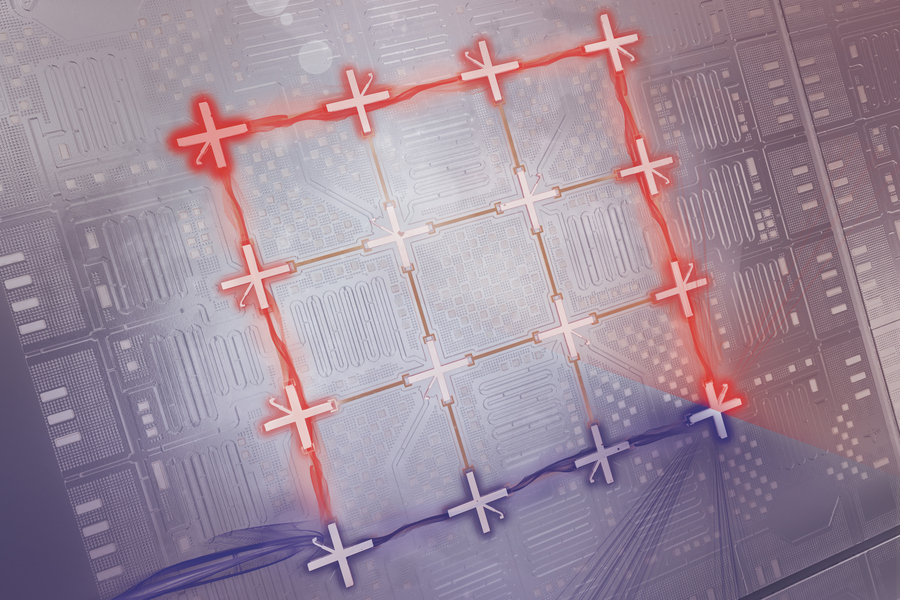MIT’s Quantum Emulator Recreates Electromagnetic Fields for Innovative Electronics Development

Insider Brief:
- MIT researchers have developed a method to emulate electromagnetic fields on a 16-qubit superconducting quantum processor, allowing new ways to explore material properties like conductivity and magnetism.
- By using microwave signals to control qubit energy levels, they simulate electron movement in magnetic fields, providing insights into material behaviors that are otherwise hard to replicate.
- This flexible quantum emulator enables material scientists to investigate a range of conditions without needing new hardware for each experiment, simplifying studies on phenomena such as electron hopping and phase transitions.
- Although challenges with qubit calibration and coupling persist, this could drive future research in high-performance materials, advancing our understanding of superconductivity and other complex material properties.
- Image credit: Eli Krantz, Krantz NanoArt
Electromagnetic fields shape the behavior of electrons within materials, influencing properties like conductivity, magnetism, and even the transition between insulators and superconductors. In a recent study, researchers at MIT demonstrated a method to emulate electromagnetic fields on a superconducting quantum processor, creating new possibilities for studying materials with the potential to inform high-performance electronics and illustrating how quantum simulation can be used as a tool to explore complex material properties.
Simulating Electromagnetic Fields with Quantum Processing
To mimic electron behavior in a magnetic field, researchers adapted MIT’s 16-qubit quantum processor, creating a synthetic electromagnetic field through controlled coupling of qubits. Ordinarily, emulating these effects on a quantum computer would require charged particles; however, MIT’s team adjusted the energy levels of each qubit using microwave signals, guiding photon “hops” in patterns that mimic electron movement between atoms in a magnetic field. This technique, described in Nature Physics, serves as a model for studying material characteristics that are otherwise challenging to capture, from conductivity to magnetization.
“Quantum computers are powerful tools for studying the physics of materials and other quantum mechanical systems. Our work enables us to simulate much more of the rich physics that has captivated materials scientists,” Rosen notes. This development allows researchers to observe and understand material properties by adjusting the processor’s microwave signals rather than creating new hardware setups for each unique material—simplifying experiments and expanding the scope of quantum emulation for materials science.
Quantum Emulators as a Tool for Material Science
Quantum simulators hold unique potential for investigating material behaviors that are beyond the reach of classical computers, as they provide an alternative to large-scale digital quantum computers, which remain in early development. “Using an analog quantum emulator, I can intentionally set a starting point and then watch what unfolds as a function of time,” says Rosen.
By creating synthetic electromagnetic fields, researchers can explore how photons—stand-ins for electrons—navigate atomic lattices, offering a closer approximation of real material properties. The team’s ability to fine-tune microwave signals enables them to emulate a variety of magnetic field conditions, allowing them to scan a range of properties like conductivity and phase transitions. According to the study, this emulation of material dynamics is important for material scientists, who require precise data to understand phenomena like electron hopping and phase shifts.
Flexibility Meets Challenge
This new quantum emulator presents flexibility that could fundamentally transform the study of condensed matter physics. MIT’s approach allows researchers to quickly adjust the modulation amplitude or frequency of qubit couplings, effectively emulating various material properties without needing new hardware for each configuration. As explained by William D. Oliver, “a nice feature of our emulator is that we need only change the modulation amplitude or frequency to mimic a different material system.”
However, the team notes that testing this synthetic field introduced several challenges. To find modulation settings that would allow all 16 qubits to work harmoniously required careful calibration of each qubit’s energy level and coupling parameters. Additionally, maintaining accurate synthetic fields involves compensating for inhomogeneity in coupling strengths across the qubit array, a limitation that the team mitigated partially by fine-tuning modulation amplitudes. Despite these efforts, residual differences in coupling strengths presented small deviations from idealized results, adding complexity to their simulations and requiring advanced numerical adjustments for accurate results.
Implications for Material Innovation and Future Research
While challenges remain, MIT’s quantum simulation method may support new research in high-performance materials. Beyond the immediate scope of material science, the synthetic electromagnetic fields produced on this quantum emulator could also deepen our understanding of superconductivity, magnetism, and other condensed matter phenomena. The possibilities are just unfolding, and as Rosen notes, “We are in a very exciting place for the future.”
Contributing authors on the study include Ilan T. Rosen, Sarah Muschinske, Cora N. Barrett,
Arkya Chatterjee, Max Hays, Michael A. DeMarco, Amir H. Karamlou, David A. Rower, Rabindra Das, David K. Kim, Bethany M. Niedzielski, Meghan Schuldt, Kyle Serniak, Mollie E. Schwartz, Jonilyn L. Yoder, Jeffrey A. Grover, and William D. Oliver.
